Contents
Sony Ericsson W610c Additional information
Getting started ................... 4
Assembly, SIM card, battery, turning
on, help, Flight mode, calls, activity
menu, PC Suite, camera.
Getting to know
the phone .......................... 10
Keys, menus, navigation, icons,
shortcuts, phone language, entering
letters, file manager, memory card.
Calling ............................... 25
Calls, contacts, call list, speed dial,
voice control, call options, groups,
business cards.
Messaging ........................ 40
Text messaging, picture messaging,
voice messaging, email, My friends.
Imaging ............................. 52
Camera, video, pictures.
Entertainment ................... 58
Handsfree, Walkman® player, Video
player, TrackID™, PlayNow™,
ringtones, MusicDJ™, VideoDJ™,
sound recorder, games, applications.
Connectivity ..................... 68
Settings, Internet, RSS, synchronizing,
Bluetooth™ technology, USB cable,
update service.
More features ................... 80
Alarm clock, calendar, tasks, profiles,
time and date, SIM card lock and
more.
Troubleshooting ............... 87
Why doesn’t the phone work the way I
want it to?
Important information ...... 93
Sony Ericsson Consumer Web site,
safe and efficient use, end user license
agreement, warranty, declaration of
conformity.
Index ............................... 101
This is the Internet version of the user's guide. © Print only for private use.
Contents
1
�
Sony Ericsson
GSM 850/900/1800/1900
This user guide is published by Sony Ericsson
Mobile Communications AB or its local affiliated
company, without any warranty. Improvements and
changes to this user guide necessitated by
typographical errors, inaccuracies of current
information, or improvements to programs and/or
equipment, may be made by Sony Ericsson Mobile
Communications AB at any time and without
notice. Such changes will, however, be
incorporated into new editions of this user guide.
All rights reserved.
©Sony Ericsson Mobile Communications AB,
2006
Publication number: EN/LZT 108 9056 R1A
Please note:
Some of the services in this user guide are not
supported by all networks. This also applies to the
GSM International Emergency Number 112.
Please contact your network operator or service
provider if you are in doubt whether you can use a
particular service or not.
Please read the Guidelines for safe and efficient use
and the Limited warranty chapters before you use
your mobile phone.
Your mobile phone has the capability to download,
store and forward additional content, e.g.
ringtones. The use of such content may be
restricted or prohibited by rights of third parties,
including but not limited to restriction under
applicable copyright laws. You, and not Sony
Ericsson, are entirely responsible for additional
content that you download to or forward from your
mobile phone. Prior to your use of any additional
content, please verify that your intended use is
properly licensed or is otherwise authorized. Sony
Ericsson does not guarantee the accuracy, integrity
or quality of any additional content or any other
third party content. Under no circumstances will
Sony Ericsson be liable in any way for your
improper use of additional content or other third
party content.
Bluetooth™ is a trademark or registered trademark
of Bluetooth SIG Inc.
PlayNow, MusicDJ, PhotoDJ, TrackID™ and
VideoDJ are trademarks or registered trademarks
of Sony Ericsson Mobile Communications AB.
Memory Stick Micro™ (M2™), WALKMAN and the
WALKMAN logo are trademarks of Sony
Corporation.
The WALKMAN® logo and symbol are registered
trademarks of Sony Corporation.
Real is a trademark or a registered trademark of
RealNetworks, Inc. RealPlayer® for Mobile is
included under license from RealNetworks, Inc.
Copyright 1995-2004, RealNetworks, Inc. All rights
reserved.
Adobe™ Photoshop™ Album Starter Edition is a
trademark or registered trademark of Adobe
Systems Incorporated.
Microsoft, Windows and PowerPoint are either
registered trademarks or trademarks of Microsoft
Corporation in the U.S and other countries/regions.
T9™ Text Input is a trademark or a registered
trademark of Tegic Communications. T9™ Text
Input is licensed under one or more of the
following: U.S. Pat. Nos. 5,818,437, 5,953,541,
5,187,480, 5,945,928, and 6,011,554; Canadian
Pat. No. 1,331,057, United Kingdom Pat. No.
2238414B; Hong Kong Standard Pat. No.
HK0940329; Republic of Singapore Pat. No. 51383;
Euro.Pat. No. 0 842 463(96927260.8) DE/DK, FI,
FR, IT, NL, PT, ES, SE, GB; and additional patents
are pending worldwide.
Java and all Java based trademarks and logos are
trademarks or registered trademarks of Sun
Microsystems, Inc. in the U.S. and other countries/
regions.
End-user license agreement for Sun™ Java™
J2ME™.
2
Contents
This is the Internet version of the user's guide. © Print only for private use.
�
1 Restrictions: Software is confidential copyrighted
information of Sun and title to all copies is retained
by Sun and/or its licensors. Customer shall not
modify, decompile, disassemble, decrypt, extract,
or otherwise reverse engineer Software. Software
may not be leased, assigned, or sublicensed, in
whole or in part.
2 Export Regulations: Software, including technical
data, is subject to U.S. export control laws,
including the U.S. Export Administration Act and its
associated regulations, and may be subject to
export or import regulations in other countries/
regions. Customer agrees to comply strictly with all
such regulations and acknowledges that it has the
responsibility to obtain licenses to export, re-
export, or import Software. Software may not be
downloaded, or otherwise exported or re-exported
(i) into, or to a national or resident of, Cuba, Iraq,
Iran, North Korea, Libya, Sudan, Syria (as such
listing may be revised from time to time) or any
country/region to which the U.S. has embargoed
goods; or (ii) to anyone on the U.S. Treasury
Department's list of Specially Designated Nations
or the U.S. Commerce Department's Table of
Denial Orders.
3 Restricted Rights: Use, duplication or disclosure by
the United States government is subject to the
restrictions as set forth in the Rights in Technical
Data and Computer Software Clauses in DFARS
252.227-7013(c) (1) (ii) and FAR 52.227-19(c) (2) as
applicable.
Part of the software in this product is copyright ©
SyncML initiative Ltd. (1999-2002). All rights
reserved.
Other product and company names mentioned
herein may be the trademarks of their respective
owners.
Any rights not expressly granted herein are
reserved.
Note: Sony Ericsson advised users to backup their
personal data information.
All illustrations are for illustration only and
may not accurately depict the actual phone.
Instruction symbols
The following appear in the user guide:
Note
A service or function is network-
or subscription-dependent.
Contact your network operator
for details.
% See also page...
}
Use a selection or navigation
key to scroll and select
% 14 Navigation.
Press the navigation key centre.
Press the upper part of the
navigation key.
Press the lower part of the
navigation key.
Press the left part of the
navigation key.
Press the right part of the
navigation key.
This is the Internet version of the user's guide. © Print only for private use.
Contents
3
�
Getting started
Assembly, SIM card, battery, turning
on, help, Flight mode, calls, activity
menu, PC Suite, camera.
More information and downloads are
available at www.sonyericsson.com/cn.
Assembly
To use your phone
1 Insert the SIM card and the battery.
2 Charge the battery.
3 Turn on your phone.
SIM card
When you register as a subscriber with
a network operator, you get a SIM
(Subscriber Identity Module) card. The
SIM card contains a computer chip
that keeps track of items such as your
phone number, the services included
in your subscription, and names and
numbers in your contacts.
Save contact information on your SIM
card before removing it from another
phone. Contacts may have been saved in
the phone memory.
PIN
You may need a PIN (Personal Identity
Number) for your SIM card to start
your phone and activate services.
When you enter your PIN, each digit
appears as *, unless it starts with the
same digits as an emergency number,
for example 112. This allows for
emergency calls without entering a
PIN. Press
to correct mistakes.
If you enter the wrong PIN three times in
a row, PIN blocked appears. To unblock
it, you need to enter your PUK (Personal
Unblocking Key) % 85 SIM card lock.
Battery
Some functions use more battery
power than others and may cause a
need for more frequent re-charging. If
talk time or standby time becomes
noticeably shorter, you may have to
replace the battery. Only use
approved batteries from Sony
Ericsson % 94 Battery.
4
Getting started
This is the Internet version of the user's guide. © Print only for private use.
�
SIM card and battery
To insert SIM card and battery
To charge the battery
1 Remove the battery cover by pressing
and sliding it as shown in the picture.
2 Slide the SIM card into its holder with
the contacts facing down.
3 Insert the battery with the label side up
and the connectors facing each other.
4 Slide the battery cover into place.
1 Connect the charger plug to the phone
with the symbol facing upwards.
2 It may take up to 30 minutes before
the battery icon appears.
3 Wait approximately 2.5 hours or until
the battery icon indicates that the
battery is fully charged. Press a key to
activate the screen.
4 Remove the charger by tilting the plug
upwards.
This is the Internet version of the user's guide. © Print only for private use.
Getting started
5
�
Turning on your phone
Make sure the phone is charged and a
SIM card inserted before turning the
phone on. After turning on, use the
setup wizard to prepare the phone for
use.
To turn on the phone
1 Press and hold
. The first start-up
may take a few minutes.
2 Select to use the phone in:
• Normal – full functionality or
• Flight mode – limited functionality with
network, FM radio and Bluetooth™
transceivers off % 7 Flight mode
menu.
3 Enter your SIM card PIN, if requested.
4 At first startup, select the language for
your phone menus.
Standby
After you have turned the phone on
and entered your PIN, the name of the
network operator will appear on the
screen. This is called standby mode.
Help in your phone
Help and information is available in
your phone at any time.
To use the setup wizard
} Settings } the General tab
} Setup wizard and select an option:
• Basic setup
• Tips and tricks
To view information about functions
Scroll to a function } More } Info, if
available.
To view the phone demonstration
} Entertainment } Demo tour.
5 } Yes for the setup wizard to help you.
6 Follow instructions to complete setup.
Predefined settings may already exist in
your phone.
6
Getting started
This is the Internet version of the user's guide. © Print only for private use.
�
Flight mode menu
If you turn on the phone and Flight
mode menu is activated, select from
Normal with full functionality or Flight
mode with limited functionality. Flight
mode means that Network, Bluetooth
transceivers and FM Radio are turned
off to prevent disturbance to sensitive
equipment. You can, for example, play
music or write a text message to send
later but not make calls.
Making calls
The phone must be in normal mode
(not flight mode).
To make a call
1 Enter a phone number (with
international prefix and area code if
applicable).
2 } Call to make a voice call.
3 } More for options during the call.
4 } End call to end the call.
Follow onboard regulations, flight crew
instructions for use of electronic devices.
To join two calls into a conference
call
To view Flight mode menu options
} Settings and scroll to the General
tab } Flight mode and select an
option.
1 Call the first person to include in the
conference.
2 } More } Hold to hold the ongoing
call.
3 Call the second person.
4 } More } Join calls.
This is the Internet version of the user's guide. © Print only for private use.
Getting started
7
�
Activity menu
You can open the activity menu
almost anywhere in the phone menus
to view and handle new events, and
access bookmarks and shortcuts.
To open and close the activity menu
Press
.
PC Suite software
Enhance the experience of your phone
by installing the PC Suite software on
your computer. This allows you to, for
example, synchronize your phone
calendar with a computer calendar.
To install the PC Suite software
1 Turn on your computer and insert the
CD that came with your phone into the
CD drive of your computer. The CD
starts automatically and the
installation window opens.
2 Computer: Select a language and
click OK.
3 Computer: Click Install in the PC Suite
section and follow the instructions on
the screen. When the installation is
complete, the PC Suite icon appears
on the desktop of your computer.
For the latest version of PC Suite, visit
www.sonyericsson.com/cn.
Activity menu tabs
• New events – such as missed calls
and messages. When a new event
occurs, the tab appears. Press
to dismiss an event from the event
tab. New events can also be set to
appear as pop-up text instead,
} Settings } the General tab
} New events } Pop-up.
• Running apps – applications that
are running in the background.
Select an application to return to it
or press
to end it.
• My shortcuts – add, delete and
change the order of shortcuts.
When you select a shortcut and the
application opens, other programs
are closed or minimized.
• Internet – your Internet bookmarks.
When you select a bookmark and
the browser opens, other programs
are closed or minimized.
8
Getting started
This is the Internet version of the user's guide. © Print only for private use.
�
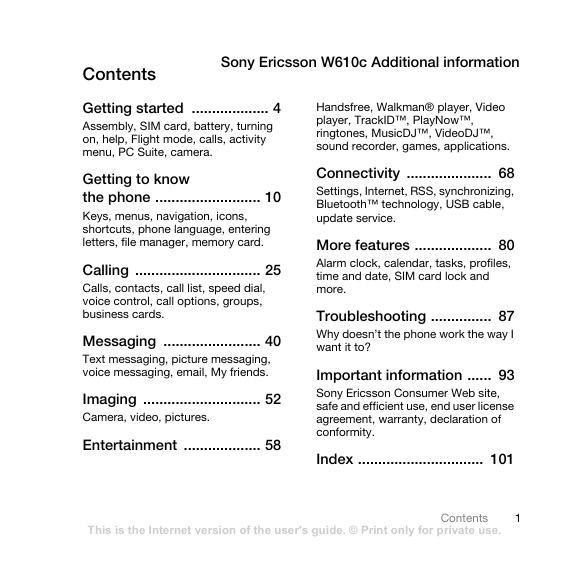
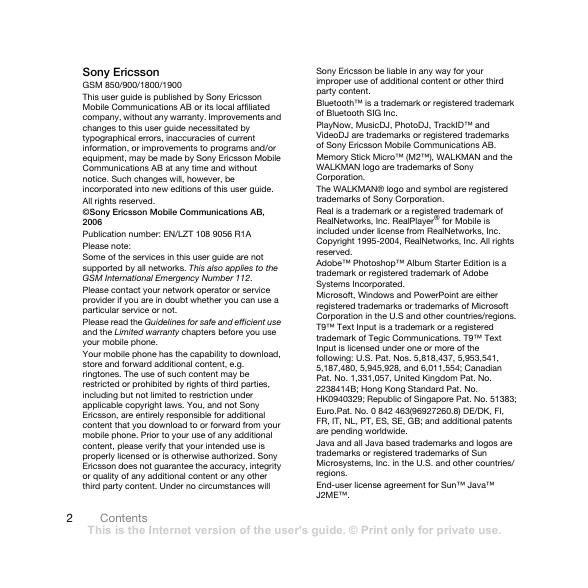
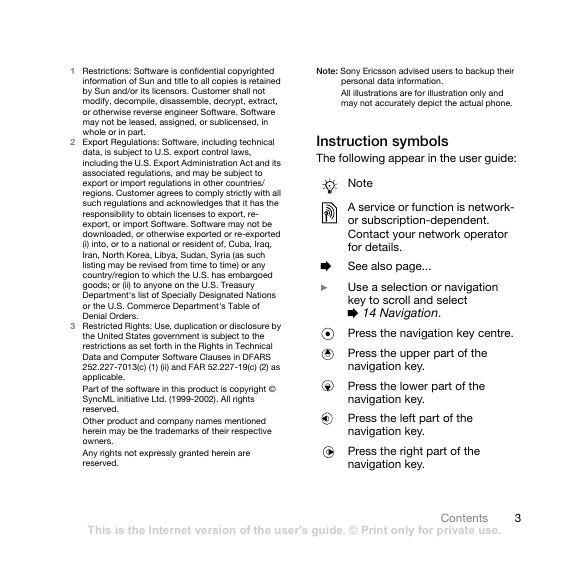
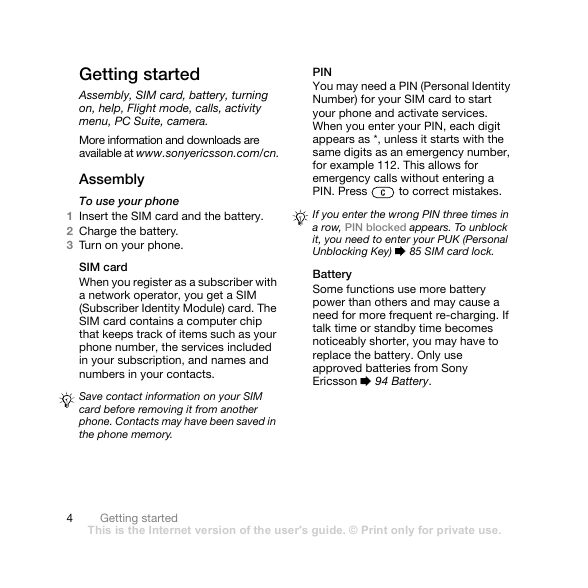

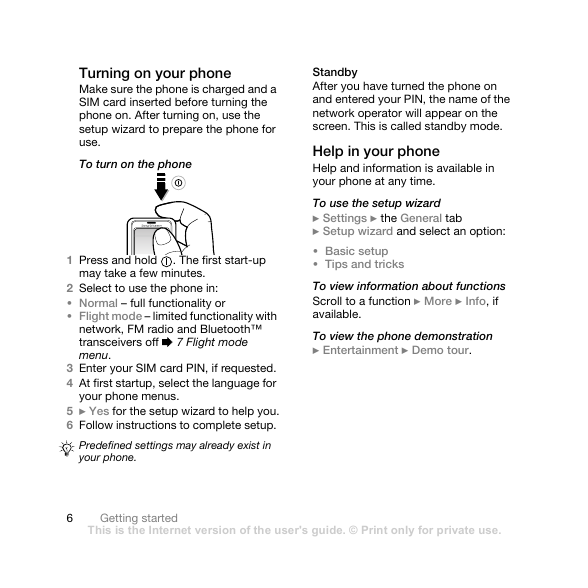










 2023年江西萍乡中考道德与法治真题及答案.doc
2023年江西萍乡中考道德与法治真题及答案.doc 2012年重庆南川中考生物真题及答案.doc
2012年重庆南川中考生物真题及答案.doc 2013年江西师范大学地理学综合及文艺理论基础考研真题.doc
2013年江西师范大学地理学综合及文艺理论基础考研真题.doc 2020年四川甘孜小升初语文真题及答案I卷.doc
2020年四川甘孜小升初语文真题及答案I卷.doc 2020年注册岩土工程师专业基础考试真题及答案.doc
2020年注册岩土工程师专业基础考试真题及答案.doc 2023-2024学年福建省厦门市九年级上学期数学月考试题及答案.doc
2023-2024学年福建省厦门市九年级上学期数学月考试题及答案.doc 2021-2022学年辽宁省沈阳市大东区九年级上学期语文期末试题及答案.doc
2021-2022学年辽宁省沈阳市大东区九年级上学期语文期末试题及答案.doc 2022-2023学年北京东城区初三第一学期物理期末试卷及答案.doc
2022-2023学年北京东城区初三第一学期物理期末试卷及答案.doc 2018上半年江西教师资格初中地理学科知识与教学能力真题及答案.doc
2018上半年江西教师资格初中地理学科知识与教学能力真题及答案.doc 2012年河北国家公务员申论考试真题及答案-省级.doc
2012年河北国家公务员申论考试真题及答案-省级.doc 2020-2021学年江苏省扬州市江都区邵樊片九年级上学期数学第一次质量检测试题及答案.doc
2020-2021学年江苏省扬州市江都区邵樊片九年级上学期数学第一次质量检测试题及答案.doc 2022下半年黑龙江教师资格证中学综合素质真题及答案.doc
2022下半年黑龙江教师资格证中学综合素质真题及答案.doc